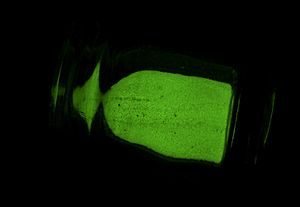Phosphor facts for kids
A phosphor is a special material. It glows when it gets energy from light. This light is usually a different color. Phosphors are not the same as the chemical element Phosphorus. That element can glow too, but in a different way. This can sometimes be confusing!
Phosphors are used in many kinds of lighting. For example, they are in fluorescent bulbs. Inside these bulbs, phosphors change invisible ultraviolet light into light we can see. This happens when mercury vapor gets excited.
Contents
What is a Phosphor?
A phosphor is a chemical compound. It has a cool ability: it can take in light of one color and then give off light of another color. Think of it like a light-changing machine! The word "phosphor" sounds a lot like "phosphorus." But they are actually different things. The chemical element Phosphorus can glow, but it does so in its own special way. Phosphors are used in many everyday items.
How Phosphors Work
Phosphors work by absorbing energy. This energy often comes from light. When a phosphor absorbs energy, its atoms get excited. They then release this energy as light. This process is called luminescence. The color of the light given off depends on the type of phosphor. Different chemicals make different colors.
Where Are Phosphors Used?
Phosphors are found in many places around you. Their chemistry changes a lot. This depends on what they will be used for.
Everyday Glowing Items
Some phosphors are used in "glow-in-the-dark" items. You might have seen these in toys or fun decorations. They also help with safety. For example, they can be found in emergency exit signs in buildings. These signs glow in the dark if the power goes out.
Old Televisions and Screens
Older cathode ray tube televisions used phosphors. These TVs had a screen that glowed. An electron beam would hit the phosphors on the screen. This made the phosphors light up. This is how the pictures on the TV screen were made.
Detecting Invisible Energy
Phosphors can also help us see things we normally cannot. They can glow when hit by ionizing radiation. This is a type of energy that is invisible to our eyes. So, phosphors can help detect this radiation.
Modern Lighting: LEDs
Many Light-emitting diodes (LEDs) use phosphors. LEDs are common in modern lights. Phosphors help LEDs create specific colors. They also help control the "color temperature." This means how warm or cool the light looks.
Related pages
See also
 In Spanish: Fósforo (sustancia fosforescente) para niños
In Spanish: Fósforo (sustancia fosforescente) para niños
Images for kids





